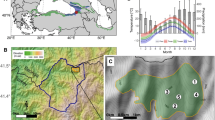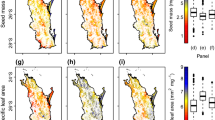Abstract
The Aspen-FACE experiment generated 11 years of empirical data on the effect of CO2 enrichment and elevated ozone on the growth of field-grown trees (maple, birch and six aspen clones) in northern Wisconsin, but it is not known how these short-term plot-level responses might play out at the landscape scale over multiple decades where competition, succession and disturbances interact with tree-level responses. In this study we used a forest landscape model (LANDIS-II) to scale these site level results to broader temporal and spatial scales. These general principles emerged from the results. (1) The productivity of taxa under future conditions is the primary determinant of short-term taxon dominance. (2) Longer-term, longevity and shade tolerance may supersede productivity as the determinant of importance, depending on the disturbance regime. This result offers hope that, even in the face of atmospheric changes, managers may have some control over future forest composition and carbon sequestration through modification of disturbance regimes. (3) Changes in the abundance of taxa were mostly gradual and none of the taxa were extirpated from the landscape, even under treatments for which they were poorly adapted. This suggests that as atmospheric conditions change, abrupt extirpations are expected to be rare. (4) Similarly, different taxa fared relatively well under different treatments. This suggests that maintaining species and genetic diversity is a prudent forest management strategy in the face of global change. (5) Accounting for spatial processes is important because seed dispersal and establishment may limit the ability of some species to colonize available habitat.








Similar content being viewed by others
References
Bandeff JM, Pregitzer KS, Loya WM, Holmes WE, Zak DR (2006) Overstory community composition and elevated atmospheric CO2 and O3 modify understory biomass production and nitrogen acquisition. Plant Soil 282:251–259
Bond WJ, Midgley GF (2000) A proposed CO2-controlled mechanism of woody plant invasion in grasslands and savannas. Glob Chang Biol 6:865–870
Burns RM, Honkala BH (1990) Silvics of North America, vol. 2, Hardwoods. USDA Forest Service Agriculture Handbook 654. Washington
Cole CT, Anderson JE, Lindroth RL, Waller DM (2010) Rising concentrations of atmospheric CO2 have increased growth of natural stands of quaking aspen (Populus tremuloides). Global Change Biol 16:2186–2197
Darbah JNT, Kubiske ME, Nelson ND, Oksanen E, Väpäävuori E, Karnosky DF (2008) Effects of decadal exposure to interacting elevated CO2 and/or O3 on paper birch (Betula papyrifera) reproduction. Environ Pollut 155:446–452
Dickson RE, Lewin KF, Isebrands JG, Coleman MD, Heilman WE, Riemenschneider DE, Sober J, Host GE, Zak DR, Hendrey GR, Pregitzer KS, Karnosky DF (2000) Forest atmosphere carbon transfer and storage (FACTS-II) the aspen free-air CO2 and O3 enrichment (FACE) project: an overview. USDA Forest Service General Technical Report NC-214. North Central Research Station, St. Paul, Minnesota, USA
Dragoni D, Schmid HP, Wayson CA, Potter H, Grimmond SCB, Randolph JC (2011) Evidence of increased net ecosystem productivity associated with a longer vegetated season in a deciduous forest in south-central Indiana, USA. Glob Chang Biol 17:886–897
Drake JE, Gallet-Budynek A, Hofmockel KS, Bernhardt ES, Billings SA, Jackson RB, Johnsen KS, Lichter J, McCarthy HR, McCormack ML, Moore DJP, Oren R, Palmroth S, Phillips RP, Pippen JS, Pritchard SG, Treseder KK, Schlesinger WH, DeLucia EH, Finzi AC (2011) Increases in the flux of carbon belowground stimulate nitrogen uptake and sustain the long-term enhancement of forest productivity under elevated CO2. Ecol Lett 14:349–357
Felzer B, Kicklighter D, Melillo J, Wang C, Zhuang Q (2004) Effects of ozone on net primary production and carbon sequestration in the conterminous United States using a biogeochemistry model. Tellus 56B:230–248
Finzi AC, Norby RJ, Calfapietra C, Gallet-Budynek A, Gielen B, Holmes WE, Hoosbeek MR, Iversen CM, Jackson RB, Kubiske ME, Ledford J, Liberloo M, Oren R, Polle A, Pritchard S, Zak DR, Schlesinger WH, Ceulemans R (2007) Increases in nitrogen uptake rather than nitrogen-use efficiency support high rates of temperate forest productivity under elevated CO2. Proc Natl Acad Sci USA 104:14014–14019
Frelich LE, Reich PB (2010) Will environmental changes reinforce the impact of global warming on the prairie-forest border of central North America? Front Ecol Environ 8:371–378
Gardner RH (2011) Neutral models and the analysis of landscape structure. In: Jopp F, Reuter H, Breckling B (eds) Modelling complex ecological dynamics. Springer, New York, pp 215–229
Gardner RH, Milne BT, Turner MG, O’Neill RV (1987) Neutral models for the analysis of broad-scale landscape pattern. Landscape Ecol 1:19–28
Gustafson EJ, Shifley SR, Mladenoff DJ, He HS, Nimerfro KK (2000) Spatial simulation of forest succession and timber harvesting using LANDIS. Can J For Res 30:32–43
He HS, DeZonia BE, Mladenoff DJ (2000) An aggregation index (AI) to quantify spatial patterns of landscapes. Landscape Ecol 15:591–601
Herrick JD, Thomas RB (1999) Effects of CO2 enrichment on the photosynthetic light response of sun and shade leaves of canopy sweetgum trees (Liquidambar styraciflua) in a forest ecosystem. Tree Physiol 19:779–786
Hogg EH, Brandt JP, Michaelian M (2008) Impacts of a regional drought on the productivity, dieback, and biomass of western Canadian aspen forests. Can J For Res 38:1373–1384
Hussain M, Kubiske ME, Connor KF (2001) Germination of CO2-enriched Pinus taeda L. seeds and subsequent seedling growth responses to CO2 enrichment. Funct Ecol 15:344–350
Karnosky DF, Pregitzer KS, Zak DR, Kubiske ME, Hendrey GR, Weinstein D, Nosal M, Percy KE (2005) Scaling ozone responses of forest trees to the ecosystem level in a changing climate. Plant Cell Environ 28:965–981
Kgope BS, Bond WJ, Midgley GF (2010) Growth responses of African savanna trees implicate atmospheric [CO2] as a driver of past and current changes in savanna tree cover. Austr Ecol 35:451–463
Kubiske ME, Pregitzer KS (1996) Effects of elevated CO2 and light availability on the photosynthetic light response of trees of contrasting shade tolerance. Tree Physiol 16:351–358
Kubiske ME, Zak DR, Pregitzer KS, Takeuchi Y (2002) Photosynthetic acclimation of overstory Populus tremuloides and understory Acer saccharum to elevated atmospheric CO2: interactions with shade and soil N. Tree Physiol 22:321–329
Kubiske ME, Quinn VS, Marquardt PE, Karnosky DF (2007) Effects of elevated atmospheric CO2 and/or O3 on intra- and interspecific competitive ability of aspen. Plant Biol 9:342–355
Luo Y, Su B, Currie WS, Dukes JS, Finzi A, Hartwig U, Hungate B, McMurtrie RE, Oren R, Parton WJ, Pataki DE, Shaw MR, Zak DR, Field CB (2004) Progressive nitrogen limitation of ecosystem responses to rising atmospheric carbon dioxide. Biosci 54:731–739
Miranda, B.R (2012) LANDIS-II-Site v2.3 User guide. http://www.landis-ii.org/users. Accessed 5 June 2013
Moran EV, Kubiske ME (2013) Can elevated CO2 and ozone shift the genetic composition of aspen (Populus tremuloides) stands? New Phytol 198(2):466–475
Norby RJ, Warren JM, Iversen CM, Medlyn BE, McMurtrie RE (2010) CO2 enhancement of forest productivity constrained by limited nitrogen availability. Proc Natl Acad Sci USA 107:19368–19373
Ollinger SV, Aber JD, Peich PB (1997) Simulating ozone effects on forest productivity: interactions among leaf, canopy and stand-level processes. Ecol Appl 7:1237–1251
Sage RF (1990) A model describing the regulation of ribulose-1,5-bisphosphate carboxylase, electron transport, and triose phosphate use in response to light intensity and CO2 in C3 plants. Plant Physiol 94:1728–1734
SAS Institute Inc. (2011) SAS/STAT® 9.3 User’s Guide. SAS Institute Inc., Cary, NC
Scheller RM (2012) LANDIS-II Biomass Succession v3.1 Extension User Guide. http://www.landis-ii.org/exts/biomass-succession/LANDIS-II%20Biomass%20Succession%20v3.1%20User%20Guide.pdf. Accessed 5 June 2013
Scheller RM, Mladenoff DJ (2004) A forest growth and biomass module for a landscape simulation model, LANDIS: design, validation, and application. Ecol Modelling 180:211–229
Scheller RM, Mladenoff DJ (2005) A spatially interactive simulation of climate change, harvesting, wind, and tree species migration and projected changes to forest composition and biomass in northern Wisconsin, USA. Glob Chang 11:307–321
Scheller RM, Domingo JB, Sturtevant BR, Williams JS, Rudy A, Gustafson EJ, Mladenoff DJ (2007) Design, development, and application of LANDIS-II, a spatial landscape simulation model with flexible temporal and spatial resolution. Ecol Model 201:409–419
Siegenthaler U, Stocker TF, Monnin E, Lüthi D, Schwander J, Stauffer B, Raynaud D, Barnola JM, Fischer H, Masson-Delmotte V, Jouzel J (2005) Stable carbon cycle–climate relationship during the late Pleistocene. Science 310:1313–1317
Smith JE, Heath LS, Skog KE, Birdsey RA (2006) Methods for calculating forest ecosystem and harvested carbon with standard estimates for forest types of the United States. USDA Forest Service General Technical Report NE-343. Northeastern Research Station, Newtown Square, PA, USA
Wu Z, Dijstra P, Koch GW, Peñuelas J, Hungate BA (2011) Responses of terrestrial ecosystems to temperature and precipitation change: a meta-analysis of experimental manipulation. Glob Chang Biol 17:927–942
Wyckoff PH, Bowers R (2010) Response of the prairie-forest border to climate change: impacts of increasing drought may be mitigated by increasing CO2. J Ecol 98:197–208
Xu C, Gertner GZ, Scheller RM (2012) Importance of colonization and competition in forest landscape response to global climatic change. Clim Change 110:53–83
Zak DR, Pregitzer KS, Kubiske ME, Burton AJ (2011) Forest productivity under elevated CO2 and O3: positive feedbacks to soil N cycling sustain decade-long net primary productivity enhancement by CO2. Ecol Lett 14:1220–1226
Acknowledgments
We thank Sue Lietz for technical assistance processing LANDIS inputs and outputs. We thank Jonathan Thompson, Jeffrey Herrick and several anonymous reviewers for critique of the manuscript. Funding provided by the Northern Research Station. The Aspen-FACE experiment was principally supported by the Office of Science (BER), U.S. Department of Energy Grant No. DE-FG02-95ER62125 to Michigan Technological University; Contract No. DE-AC02-98CH10886 to Brookhaven National Laboratory; Office of Science (BER), U.S. Department of Energy Interagency Agreement No. DE-AI02-09ER64717 to the US Forest Service, Northern Research Station; the US Forest Service Northern Global Change Program; and the Canadian Forest Service.
Author information
Authors and Affiliations
Corresponding author
Rights and permissions
About this article
Cite this article
Gustafson, E.J., Kubiske, M.E., Sturtevant, B.R. et al. Scaling Aspen-FACE experimental results to century and landscape scales. Landscape Ecol 28, 1785–1800 (2013). https://doi.org/10.1007/s10980-013-9921-x
Received:
Accepted:
Published:
Issue Date:
DOI: https://doi.org/10.1007/s10980-013-9921-x




